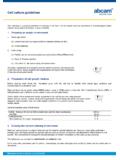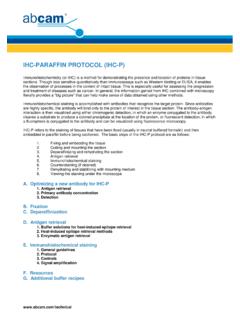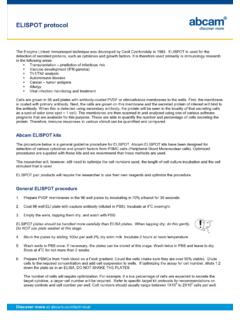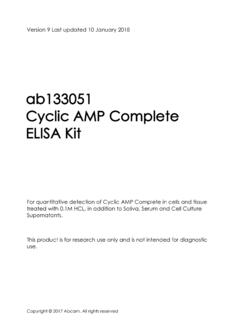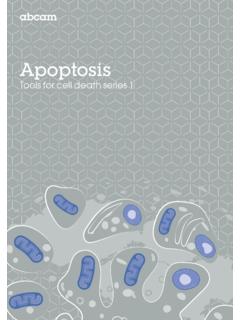Transcription of General protocols for inducing apoptosis in cells - …
1 Discover more at General protocols for inducing apoptosis in cells apoptosis may be induced in experimental systems through a variety of methods. In General , they can be divided into 2 categories: a) biological induction; and b) chemical induction. A) Biological induction of apoptosis 1. Activation of either Fas or TNF-receptors by the respective ligands or by crosslinking with agonist antibody induces apoptosis of Fas- or TNF receptor-bearing cells . Below is General protocol used to induce apoptosis using anti-Fas mAb in Jurkat cells . 2. Grow Jurkat cells in RPMI-1640 medium containing 10% fetal bovine serum in a humidified, 5% CO2 incubator at 37 C. 3. Suspend the cells in fresh medium at a concentration of 1 105 cells /ml.
2 After two to three days of incubation in a 37 C, 5% CO2 incubator, harvest the cells by centrifugation at 300 350 g for 5 mins. 4. Resuspend cells in fresh medium to 5 105 cells /ml and add anti-Fas mAb to a final concentration of g/ml. 5. Incubate for 3 6 hours in a 37 C incubator. As a negative control, incubate untreated cells (no anti-Fas mAb) under the same conditions. (Stop here for homogeneous assay, or plate the cells in a 96-well plate.) 6. Harvest the cells by centrifugation at 300 350 g for 5 mins. 7. Remove all medium and resuspend cells in PBS. 8. Repeat centrifugation and resuspend the cell pellet in PBS to 106 cells /ml. 9. Proceed to apoptosis detection. B) Chemical induction of apoptosis Depending on the agent selected and the concentrations used, maximal induction of a particular protein may occur within 8 to 72 hours post-treatment.
3 However, not all proteins are affected by reagents in a particular cell line. The following protocol is based on p53-dependent G1-arrest that occurs in response to DNA damage by chemical agents. A typical time course for p53 induction is 40 to 48 hours treatment with a DNA damaging agent. 1. Inoculate each of 2 or more 10 cm2 tissue culture dishes for adherent cells or T-75 flasks for non-adherent cells with approximately 1 x 106 cells . One dish or flask will be used as negative control for non-induced or basal level expression. 2. Confirm that cells are growing by visual inspection of tissue culture dishes or by viable cell counts on non-adherent cells in T-75 flasks. Add DNA damaging agents to recommended final concentrations.
4 The list below gives suggestions of final concentrations that can be used for several well known apoptosis inducing chemicals: Examples: g/ml Doxorubicin (stock prepared in H2O, 25 g/ml) 5-Fluorouracil (stock prepared in DMSO) 100-58 nM Paclitaxel (stock prepared in DMSO) 60 nM Vinblastine (stock prepared in methanol) 1 mM staurosporine in DMSO Add appropriate volume of buffer or solvent ( DMSO) to the non-induced control. 3. Check cells to determine if cells have begun to apoptose. This can be assessed by checking the morphology of the cells ( cells will become granulated and blebbing may be observed). Viability can be checked using trypan blue cell counting.
5 Harvest cells if greater than 75% of the cells appear to have died upon trypan blue viability counting. Discover more at 4. Harvest cells and prepare lysates for either western blotting or immunoprecipitation. For any agent used, a time course of induction can be performed by inoculating additional dishes or flasks and harvesting at various times ( 24, 48 and 72 hours) after addition of the DNA damaging agent. For the examination of apoptotic proteins, dead cells should also be collected. Always compare levels of p53 from treated cells and controls to confirm induction.
